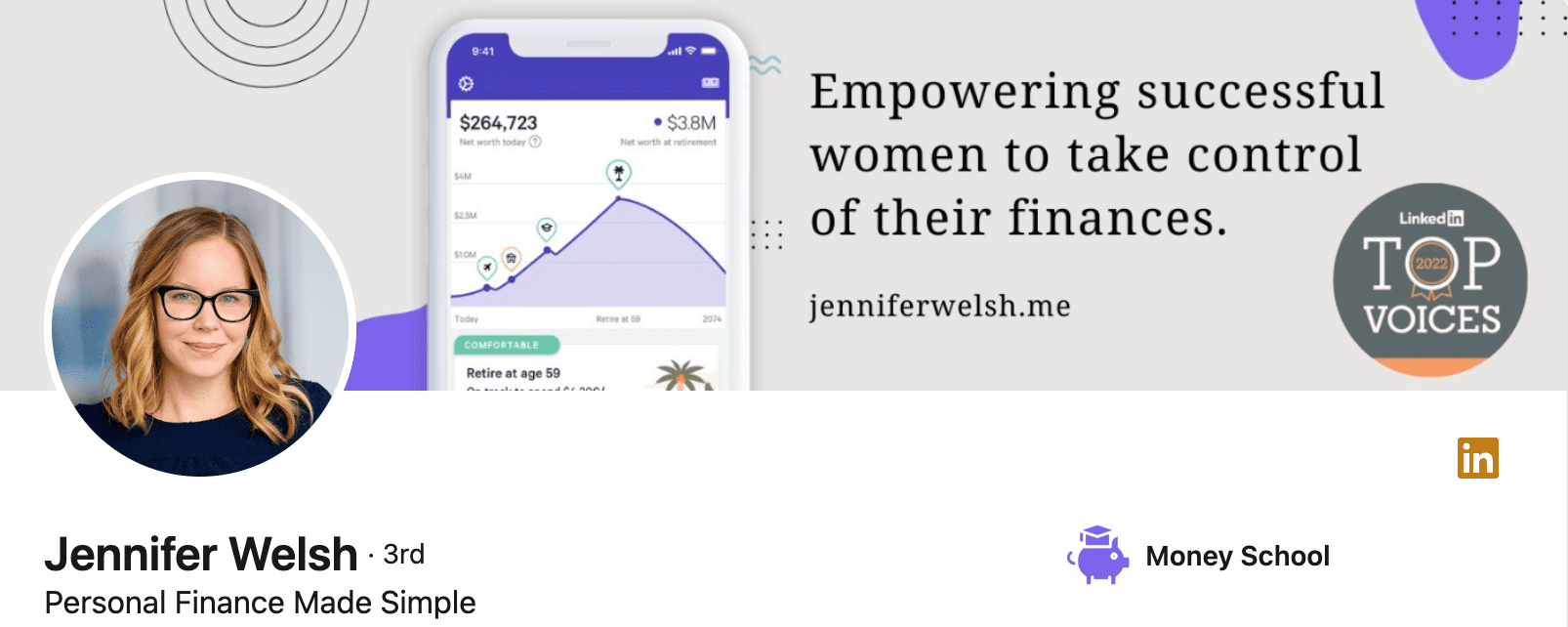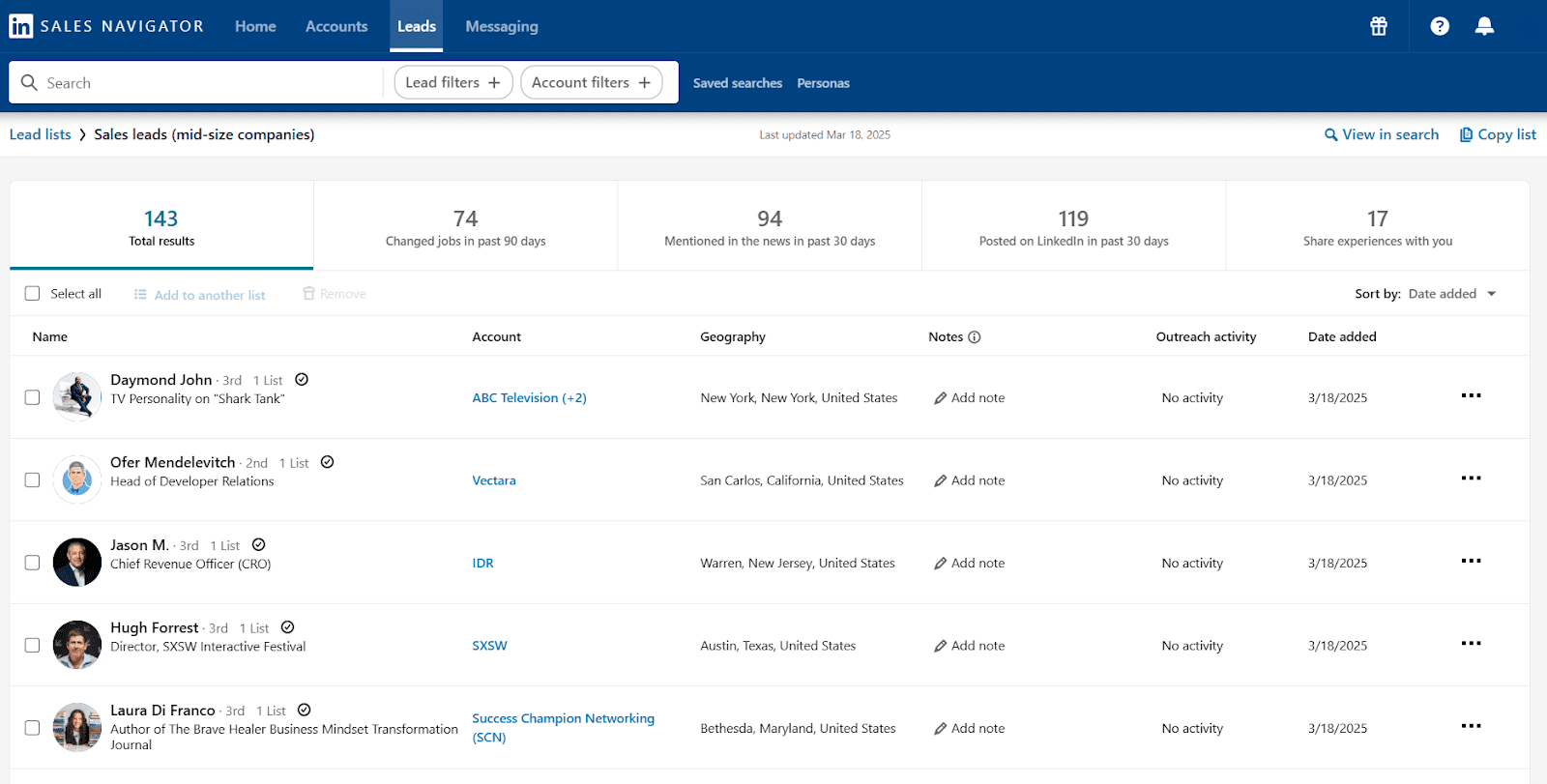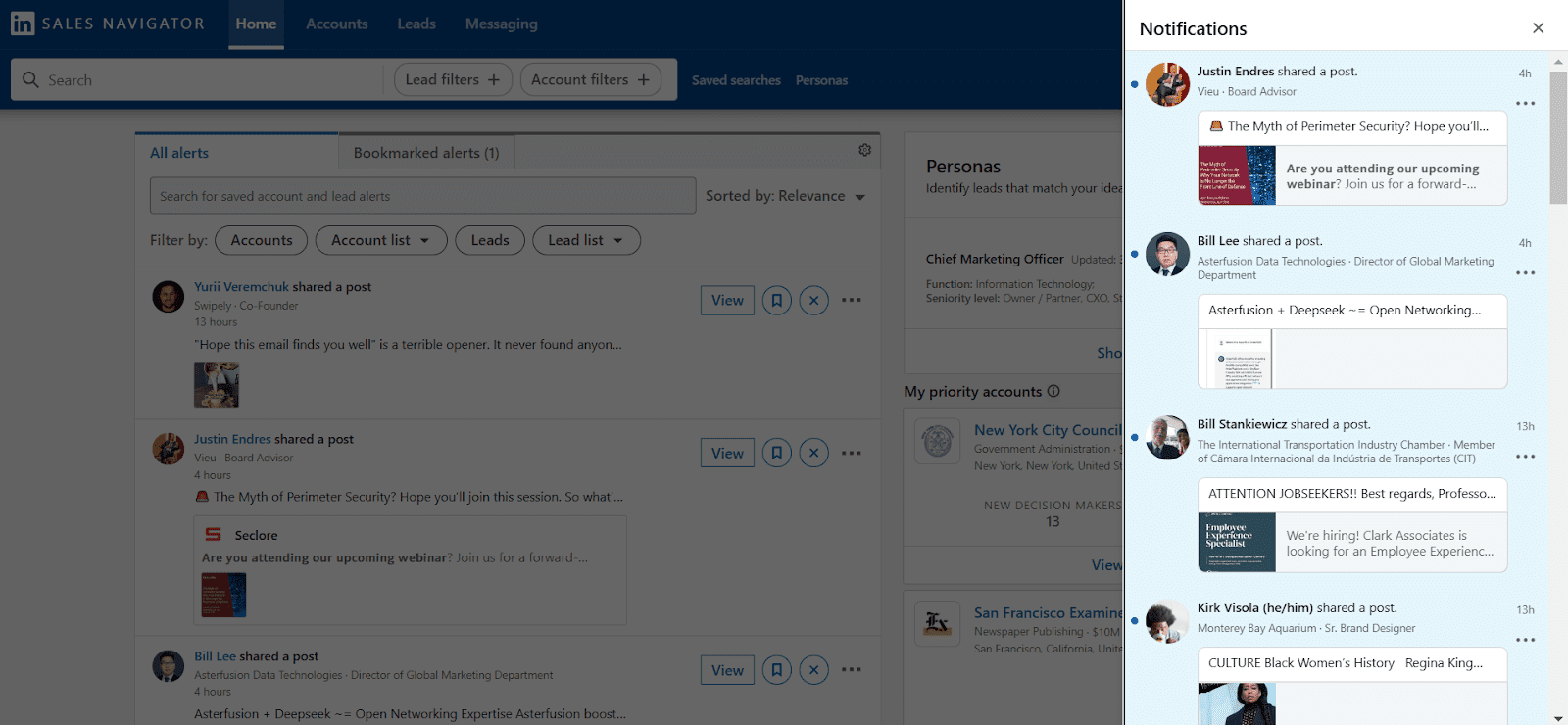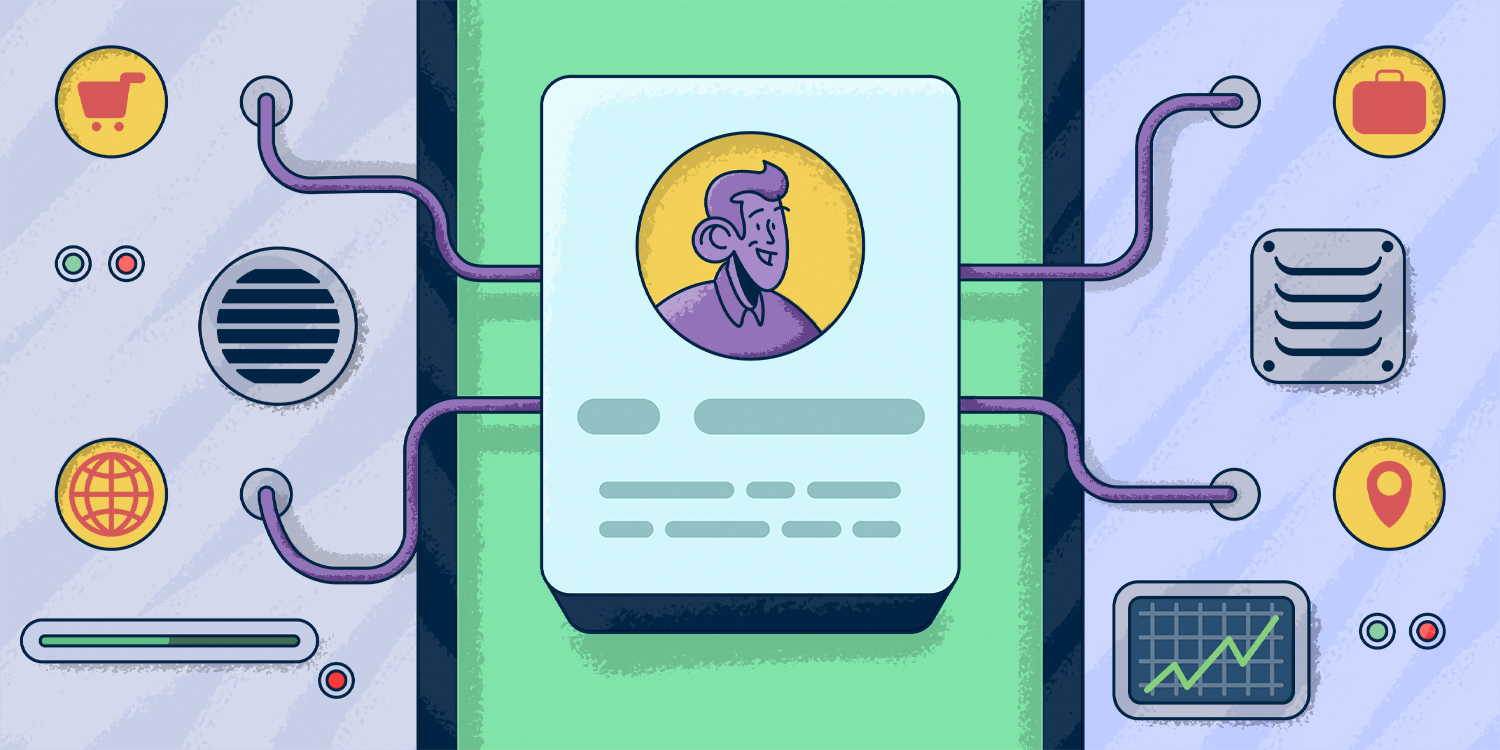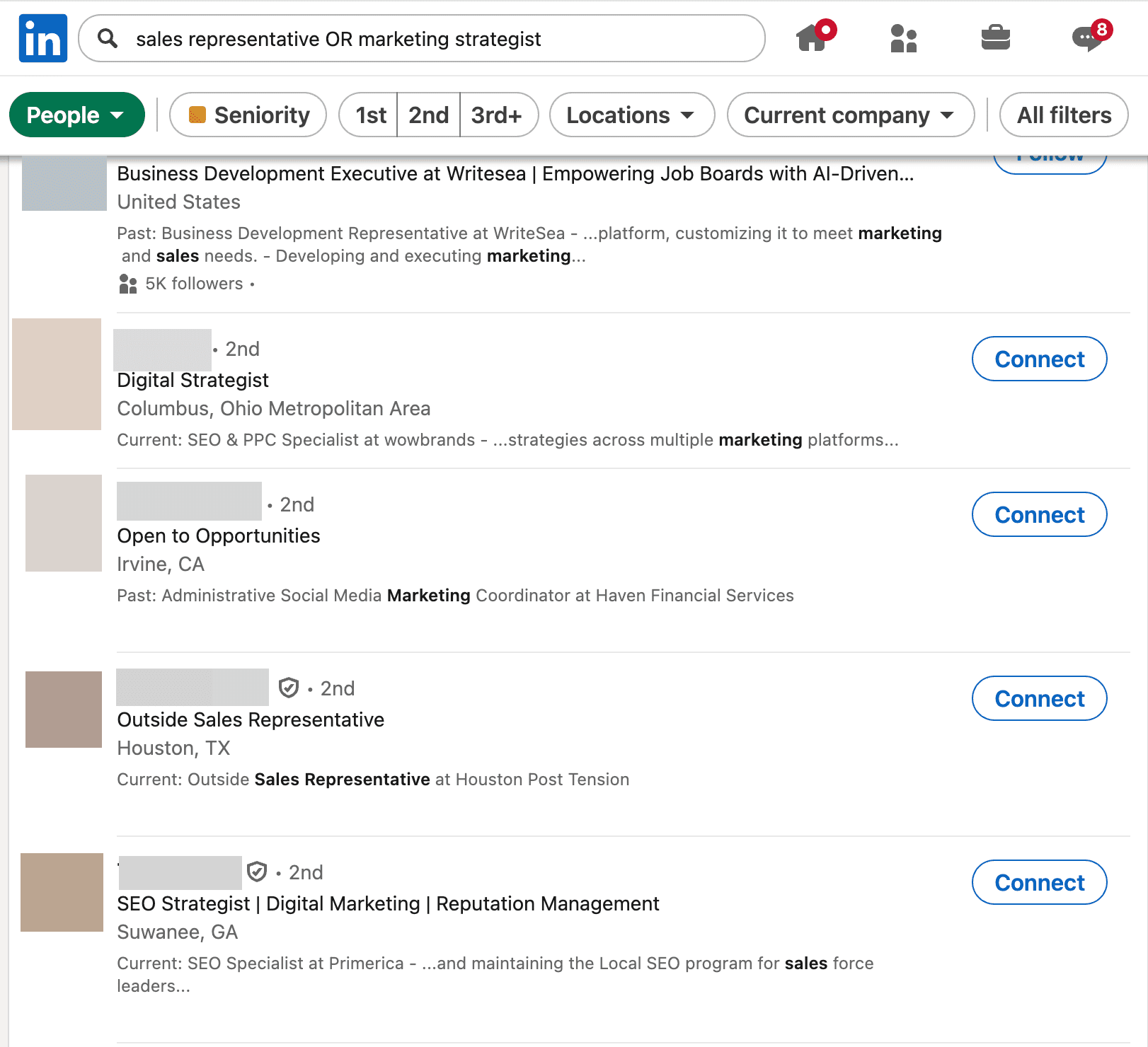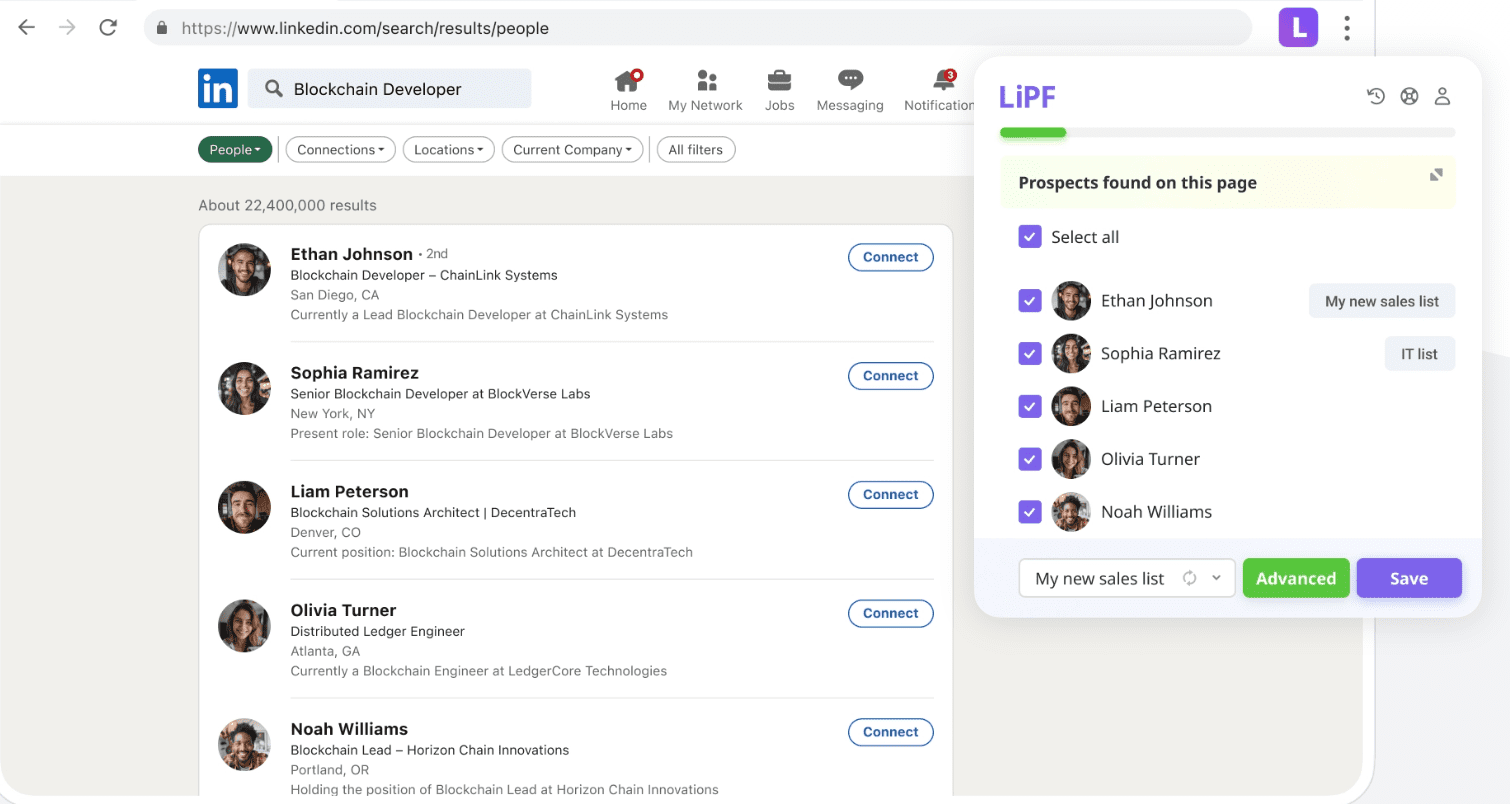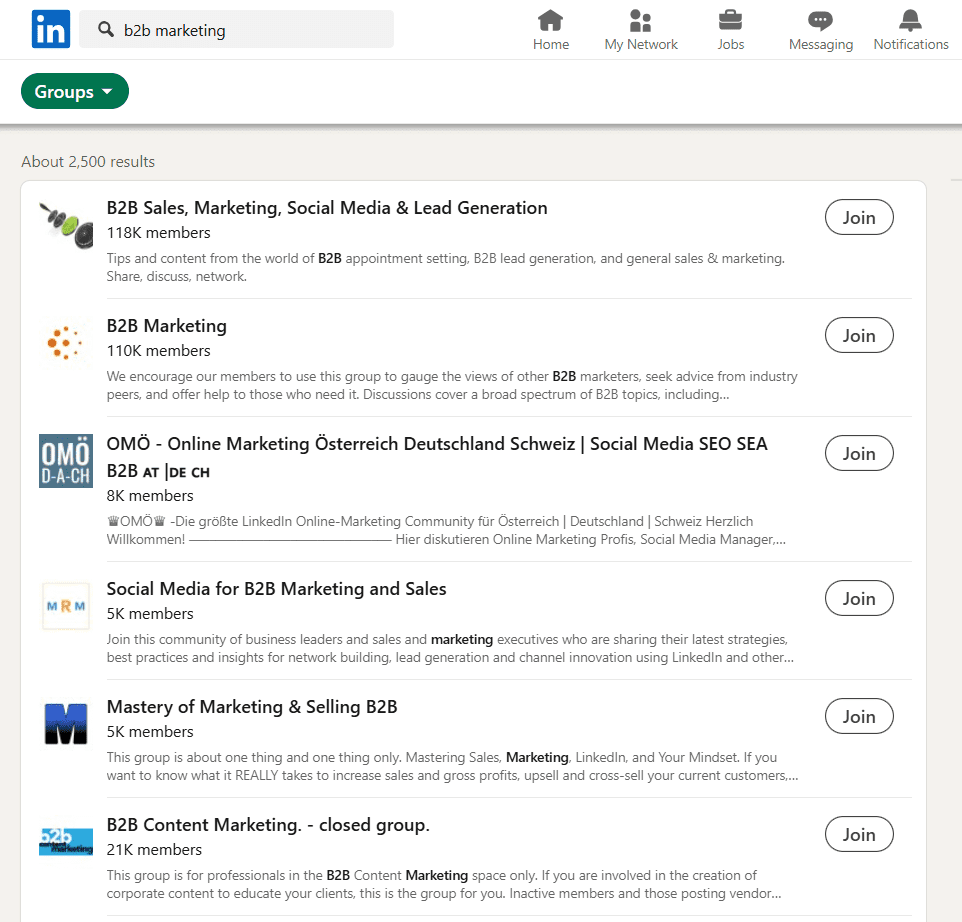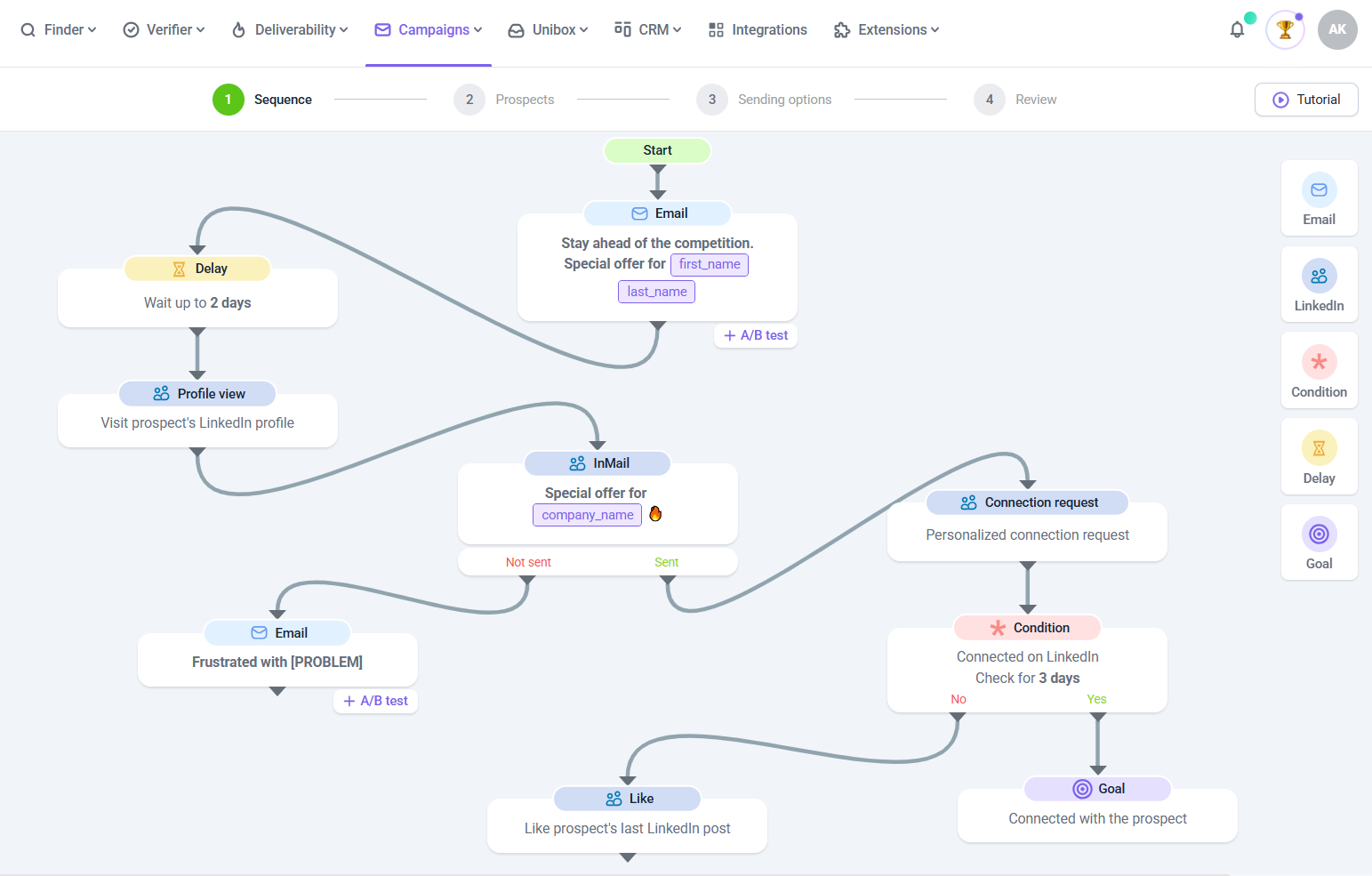TL;DR:
This LinkedIn lead generation guide covers 11 high-impact LinkedIn lead generation strategies, each packed with practical tips on how to get leads from LinkedIn with the highest efficiency. It also describes LinkedIn lead generation tools that can help you find, engage, and convert B2B leads even faster.
Today, LinkedIn is a true goldmine for reaching high-quality prospects. However, you won’t drive much value to your business through this platform unless you use a strategic approach to LinkedIn B2B lead generation.
At Snov.io, we’ve prepared an expert guide with LinkedIn lead gen best practices for 2026. Whether you’re a budding entrepreneur, a sales professional, or a B2B marketer, these strategies will help you generate leads on LinkedIn faster and cost-effectively.
What you’ll learn from this guide:
What is LinkedIn lead generation?
LinkedIn lead generation means identifying, connecting with, and nurturing potential clients or business opportunities through the platform’s professional network. This process goes beyond simply adding contacts.
LinkedIn B2B lead generation is about building meaningful connections with decision-makers, industry peers, and prospects who are more likely to bring value to your business. It can be a mutually beneficial partnership, a closed deal, revenue increase, and other growth opportunities.
Inbound vs outbound LinkedIn lead generation
You can generate leads on LinkedIn in two ways: inbound or outbound.
Boosting inbound lead generation efforts on the platform means elaborating on a compelling company and product profile, posting engaging content, using LinkedIn Ads to promote it, etc. The aim of this approach is to raise brand awareness and draw potential customers’ attention to the product or service.
Outbound lead generation is about how a company itself is looking for and reaching out to potential customers. It presupposes effective prospecting techniques, targeted advertising, and sending outreach campaigns aimed at building stronger relationships with prospects via direct communication.
So, which way should businesses go?
You got it! The ideal recipe is to mix both approaches as it allows targeting broader audiences and expanding reach.
Why use LinkedIn for lead generation
If you’ve been on the platform for a while but still doubt it’s worth the effort, these advantages of LinkedIn lead generation may help clear things up:
- B2B focus: With 63 M+ business decision-makers and over 69 million companies listed, LinkedIn is a perfect platform for B2B lead generation and outreach.
- High-quality audience: A large share of users are high-income professionals, meaning your LinkedIn lead generation efforts are more likely to convert into real business value.
- Targeting options: The platform offers filters to find the right people on the platform, such as job title, industry, company size, and more. This lets you reach leads that match your Ideal Customer Profile (ICP).
- Built-in outreach and prospecting tools: From Sales Navigator to InMails, LinkedIn provides powerful built-in features to streamline your lead generation and outreach.
- Cost-effectiveness: Using organic LinkedIn prospecting techniques, you can generate leads without relying on a big budget.
Not sure if LinkedIn can drive leads for your business? SalesBread, a LinkedIn lead generation agency, says their B2B clients see a 19.98% average reply rate from buyers using ultra-personalized LI outreach.
|
Key takeaways: In addition to a vast pool of professionals and companies listed, LinkedIn offers advanced features for both inbound and outbound prospecting and outreach. The platform enables targeting high-quality leads and fostering strong, lasting relationships with them. |
Key elements of LinkedIn lead generation
Sometimes, navigating LinkedIn lead generation tools can feel like conducting an orchestra—you should have a keen sense of timing, a dash of creativity, and the right mix of three elements:
- Content
- Outreach
- LinkedIn Ads
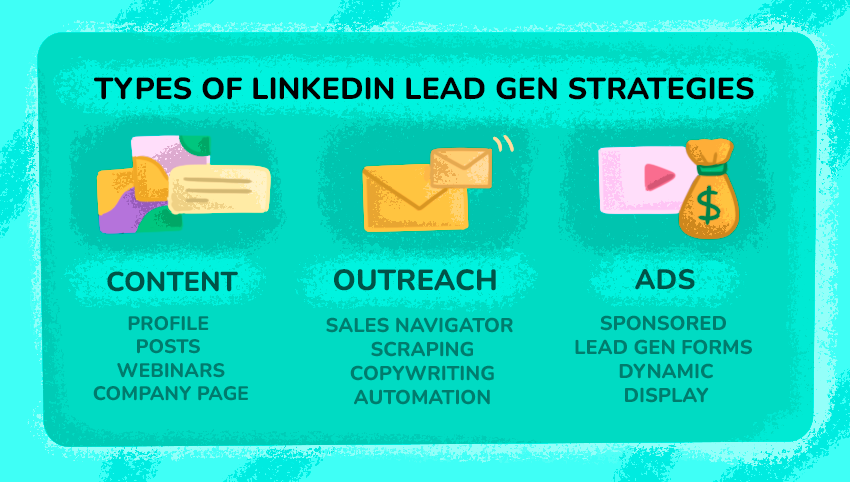
1. Content for lead generation
It’s all about how you engage with your audience to attract more leads. The key rule you should follow while preparing content is to provide value. Whether through insightful posts showcasing your expertise, webinars proving you’re a thought leader, or a well-curated company update, your content should be irresistibly “share-worthy.”
2. Outreach
When discussing outbound lead generation, outreach is the next step after LinkedIn prospecting. The main principles of a high-quality LinkedIn outreach are:
- personalization,
- follow-ups, and
- automation.
Automation tools are particularly popular for LinkedIn B2B lead generation these days, as they enable you to scale outreach while reducing costs and enhancing ROI.
|
⚠️ IMPORTANT: Ensure the security of the tools you use When choosing from LinkedIn lead generation tools to automate your efforts, check out how they guarantee safety and data protection. For example, Snov.io provides high-level security by protecting your business data with built-in proxies for each LinkedIn account and cloud-based servers. Besides, its LinkedIn automation tool simulates human behaviour by making smart delays between actions and following safety limits. This helps prevent the detection of automated activity, enabling you to automate your outreach without the risk of account restriction. Snov.io also monitors pending requests and lets you withdraw them all at once. These actions let you prevent a negative impact on your Social Selling Index, which is crucial when generating leads on LinkedIn. |
3. LinkedIn Ads
Ads are bold, they’re bright, and if done right, they make you want to take the next exit. With tools like Sponsored Content and LinkedIn Lead Gen Forms, you’re not throwing darts in the dark. You’re targeting with the precision that complements your content and outreach efforts.
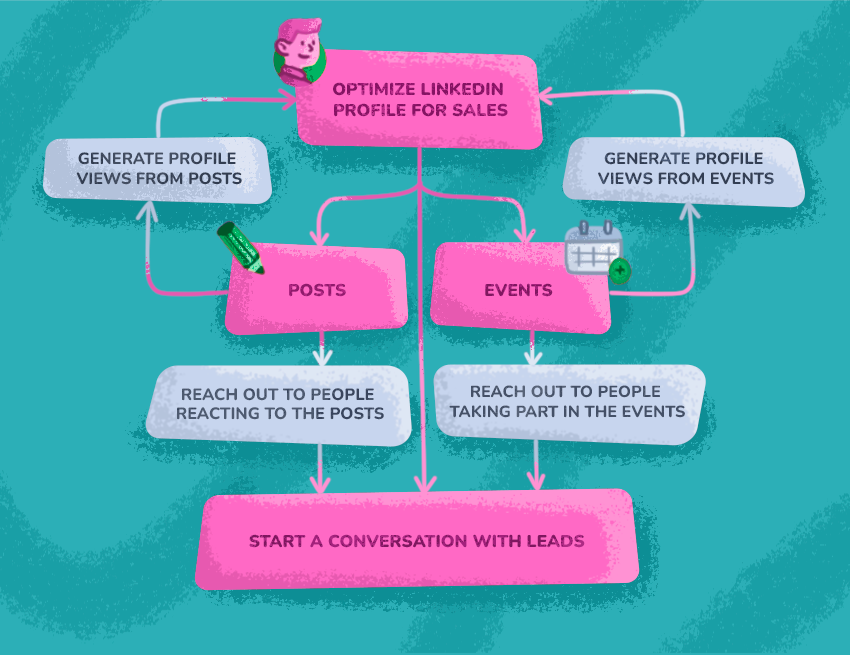
But how to make these LinkedIn lead generation strategies play in sweet harmony? It’s not really hard if you do some preparation beforehand.
How to prepare for LinkedIn lead generation: 3 easy steps
Before implementing advanced LinkedIn prospecting techniques and other strategies, make sure you follow the basic preparatory steps:
Step 1. Define the target audience
Start by identifying your ideal customer. Consider their key characteristics, such as industry, company size, location, job titles, etc. Think about your customers’ pain points that you can address to tailor communication further.
Then build buyer personas from these insights. These should be more detailed descriptions of your ideal decision-makers, including their goals, challenges, and typical behavior on LinkedIn.
A clearly defined target audience not only enables you to do LinkedIn prospecting more precisely but also helps you come up with resonating messages.
Step 2. Optimize your LinkedIn profile for lead generation
A complete LinkedIn profile is the first impression you make when you send a connection request. Would you trust a business with a lackluster website? Probably not. The same goes for your LinkedIn page, which is your online business ID card.
Here are some practical tips on how to make it sharp:
- Profile picture: Forget about selfies. Choose a professional photo that shows you mean business. It’s like the friendly nod across the room before a meeting.
- Headline: It should be a hook that gets people curious. Make it clear, compelling, and specific to your expertise.
- Banner image: That must be the first lead generation ad on your page. Use this space to visually communicate what you do and who you help.
- About section: This is where you tell your professional story, but not your autobiography. Keep it concise but impactful. Share what problems you solve, how you make your clients’ lives easier. But go beyond listing job titles, detailing how each role contributed to your skill set.
- Featured posts: It’s like a mini-portfolio of your best hits. Choose content that highlights your expertise and the solutions you offer, and pin these postings to your profile.
Another reason why profile optimization must be one of your LinkedIn lead gen best practices for 2026 is that it directly supports your social selling success on LinkedIn. The higher your Social Selling Index (SSI), the more visibility and trust you gain on the platform.
→ Learn more hacks on LinkedIn profile optimization with our free guide 🎁
Step 3. Prepare a lead-generation content plan
Think about what content you’ll be posting that will add real value and position you as an authority in the industry. Be it blog articles, social media posts, or videos, you should always address the pain points and interests of your target audience.
Types of content to consider
- Story-telling: Everyone loves a good story. Schedule some posts that will tell the audience about recent challenges you overcame or successful case studies. Such content humanizes your brand and makes you more relatable.
- How-Tos: Include tutorials or step-by-step guides relevant to your industry in your plan. It shows your expertise and willingness to help others.
- Interactive content: Think of adding some posts that will spark interaction, such as a white paper you’ll offer in exchange for comments or a poll.
Posting timing and frequency
According to Snov.io marketing experts, the optimal time to post on LinkedIn is mornings and midday during the workweek. However, you’d better analyze the most active days and hours for your target audience and tailor the posting schedule accordingly.
11 Best LinkedIn lead generation strategies for 2026
Now, let’s explore the most effective LinkedIn lead generation tips and best practices you should mix for marketing and sales growth:
- Search leads with LinkedIn Sales Navigator
- Make the most of LinkedIn’s free search
- Use LinkedIn prospecting tools
- Use the Educate+Engage formula for sharing content
- Leverage LinkedIn groups for lead generation
- Engage LinkedIn leads via InMails
- Leverage employee advocacy
- Use webinars and Live events for lead generation
- Leverage LinkedIn ads
- Craft PDF lead magnets to empower LinkedIn outreach
- Enhance lead generation with omnichannel marketing
1. Search leads with LinkedIn Sales Navigator
Lead generation on LinkedIn is hard to imagine without the precision toolset provided by Sales Navigator. It’s designed to cut through the noise and directly connect you with the right prospects. What’s more, Sales Navigator is an ideal choice for account-based marketers.
Here’s how you can use Sales Navigator most effectively:
Leverage advanced search filters
Sales Navigator equips you with over 50 advanced filtering options to enhance your LinkedIn prospecting. Whether you’re targeting a specific industry, company size, or recent job changes, these filters enable you to pinpoint your ideal audience with precision.
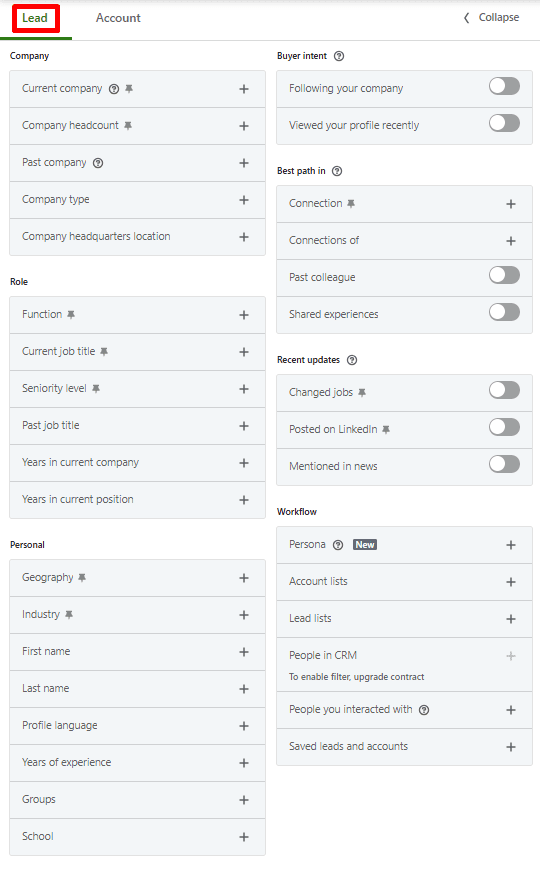
Build customized lead lists
Create lists based on your refined search criteria, monitor updates from these leads, and enjoy lead recommendations adapted to your business needs.
Engage with decision-makers
Using Sales Navigator for LinkedIn prospecting enables you to easily identify and reach out to influential figures in your target markets. For example, pinpointing CTOs in tech companies becomes a task of a few clicks, allowing you to customize your outreach effectively.
Stay updated on prospect activities
Sales Navigator keeps you in the loop with real-time updates like job changes, company announcements, or posts by your leads. These insights are invaluable for timing your outreach messages perfectly.
Integrate with your CRM
Sales Navigator’s ability to integrate with various CRM systems enhances your overall sales strategy and ensures consistent tracking and management of leads. If the data on LinkedIn doesn’t match the info on your CRM, Sales Nav will flag it, allowing you to update the contact right within the platform.
Although Sales Navigator will require some investment on your part, it’s a powerful tool for making your LinkedIn prospecting efforts more targeted and results-driven.
2. Make the most of LinkedIn’s free search
If your budget is too tight to afford LinkedIn Sales Navigator, don’t get discouraged. You can spot a good portion of potential leads with a smart use of basic LinkedIn lookup algorithms. Here are some working LinkedIn lead generation tips to note:
Leverage Boolean search
By playing with Boolean operators ‘AND’, ‘OR’, or ‘NOT’, you can narrow down your lookup to the most relevant leads.
For example, if you’re looking for a sales specialist and simply type this job position in a search bar, LinkedIn may provide you with related positions as well.
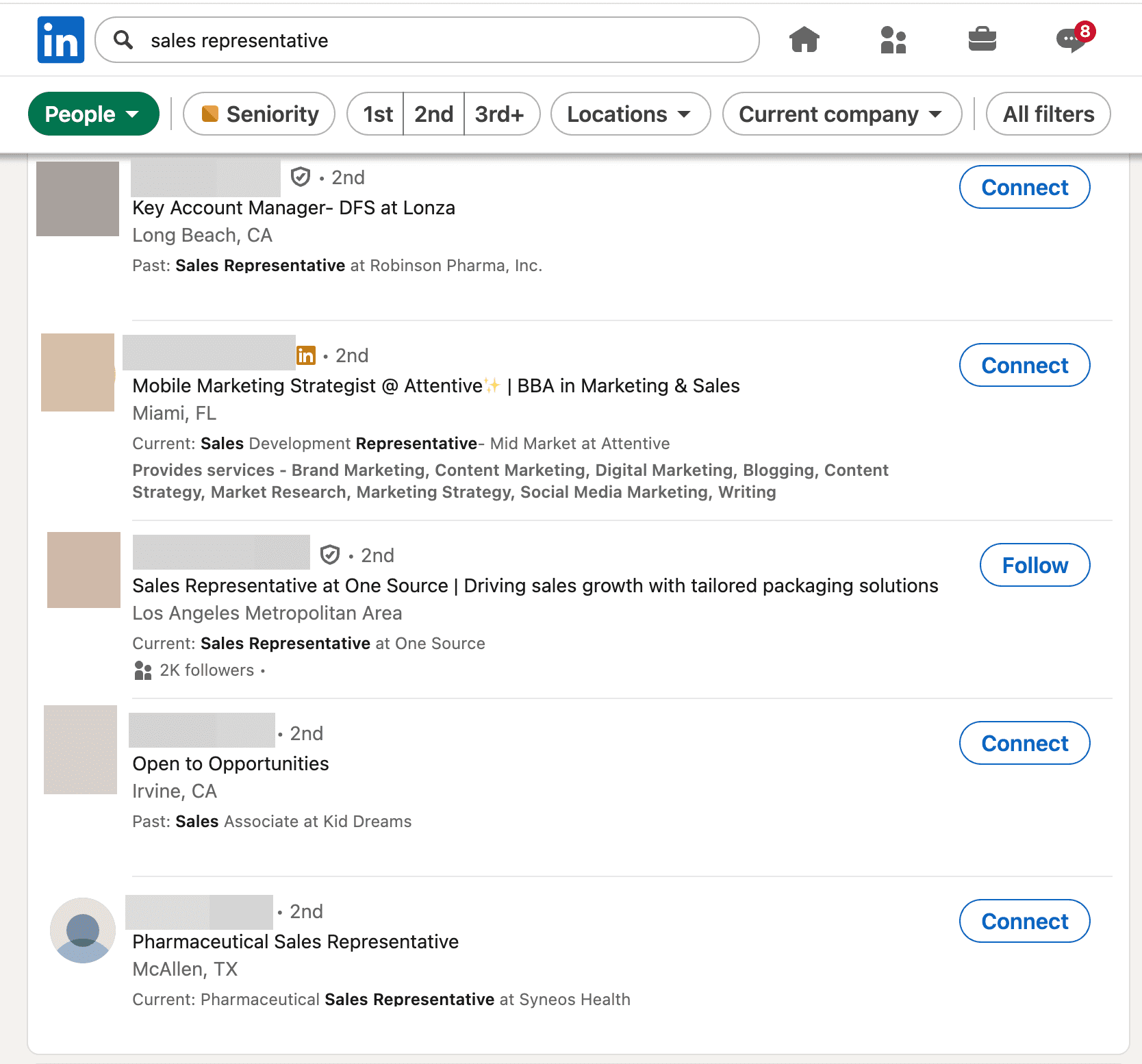
As you can see, LinkedIn also included ‘marketing strategist’ and ‘key account manager’ in the results. If you don’t want to see any irrelevant results in the search results, simply write the following Boolean string: sales representative OR marketing strategist:
Search by hashtags
People usually crown their LinkedIn posts with relevant hashtags, so why not use them to your advantage? With the right hashtag, you may learn more about users’ pain points and even spot your competitor’s dissatisfied customers, aka your potential leads:)
All you need to do is type in a respective hashtag, choose the company that should be mentioned (your competitor), and sort out the search by Posts:
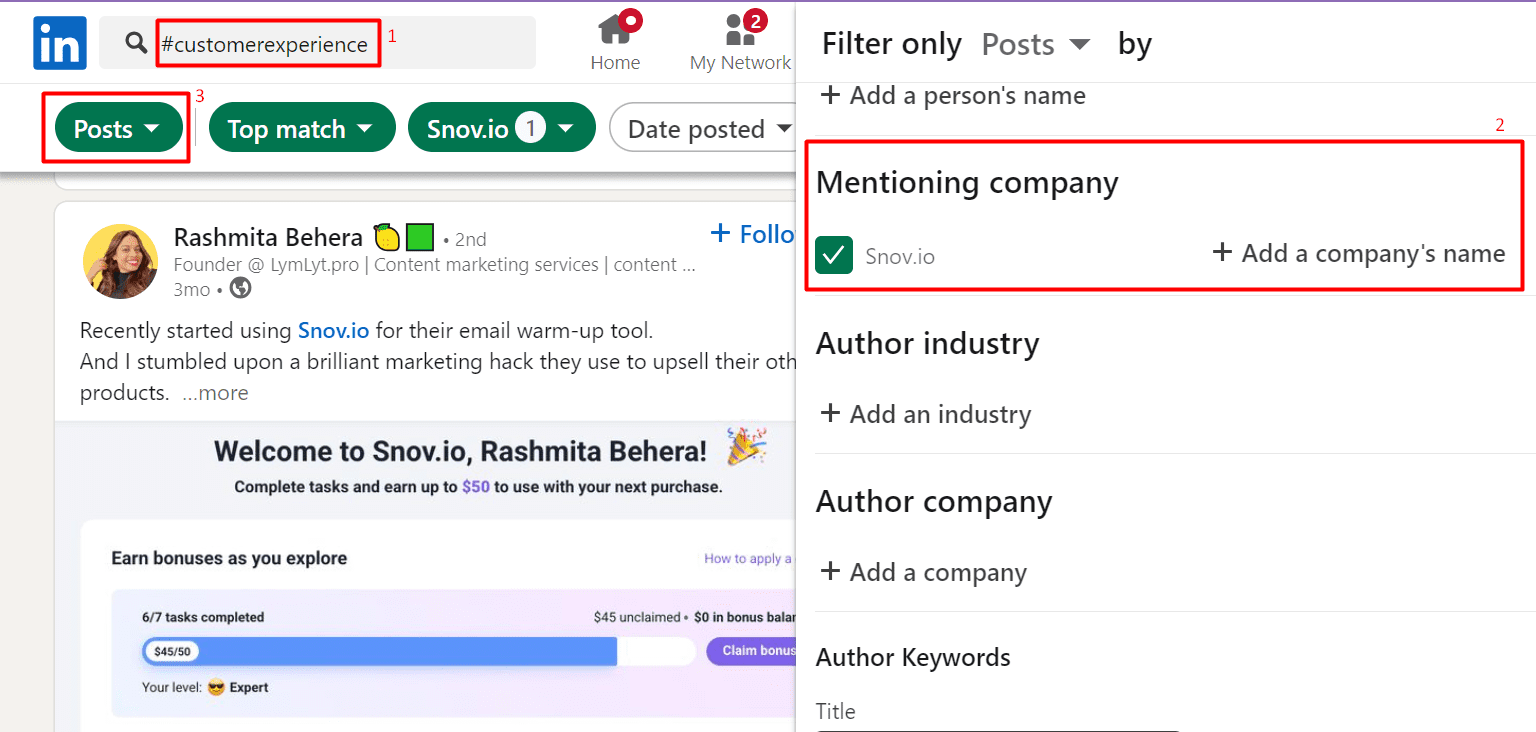
3. Use LinkedIn prospecting tools
Leveraging automation is without a doubt one of LinkedIn lead generation best practices for 2026. These days, businesses are focused on accelerating their processes, so choosing a reliable solution that could automate LinkedIn prospecting is a smart investment. With tools like Snov.io, you can extract LinkedIn leads and their contacts within minutes.
How to get leads from LinkedIn with prospecting tools
Start with finding leads that match your ideal customer profile. Use LinkedIn filters, such as position, location, industry, etc., to narrow your search. Then, extract email addresses with LinkedIn extension (Below, I’ll show how to do it with Snov.io LI Prospect Finder):
When using Snov.io for generating leads, you get a solid base of LinkedIn profiles enriched with their name, location, position, and emails. All email addresses collected with the Snov.io LI Prospect Finder are already verified, so you won’t have to validate them additionally and can ensure your email efforts won’t be wasted.
|
📌 Discover more benefits of this strategy LinkedIn outreach has its limitations. It’s highly recommended to send no more than 100 connection requests per week to avoid account restrictions. By extracting email contact information from LinkedIn, you can move the conversation outside the platform. This will enable you to scale your outreach while bypassing LinkedIn limits. |
4. Use the Educate+Engage formula for sharing content
You already know that content creation and sharing are one of the key steps in generating quality leads on LinkedIn. To maximize success, you should mix outbound and inbound strategies, remember?
Nothing works better for B2B lead generation than a mix of educational content and easy-going, engaging posts. Why? Because it speaks to both a rational and emotional side of the audience. You provide value through your expertise while keeping followers interested and entertained.
There’s nothing better for a LinkedIn post than a text paired with a real-life photo (ideally of you) or a text plus video (also featuring you). Don’t be afraid to go with unpolished videos of average quality — authentic content drives more engagement and thus ranks higher.
Marketing Specialist at Snov.io
5. Leverage LinkedIn groups for lead generation
Apart from being busy discussion forums, LinkedIn groups are also targeted communities where you can connect with peers, industry leaders, business partners, and, of course, potential customers. LinkedIn groups offer a rich space for you to demonstrate your expertise and attract more people to your product or service.
Let’s discuss how to get leads from LinkedIn groups most effectively.
Choose the right communities
Select groups that align with your industry, interests, or target market. For instance, if you’re in B2B marketing, join groups like “B2B Marketing Professionals” or “Content Marketing Institute,” where discussions are more likely to be relevant to your field.
Engage to build authority
Rather than just observing, dive into discussions. Here are some practical ways to engage:
- Initiate conversations that encourage engagement. You can post a thought-provoking question or conduct a poll on a current industry trend. For instance, a question like “What do you think will be the biggest challenge for digital marketers in 2026?” can spark meaningful conversations and draw attention to your expertise.
- Respond to questions. If anyone asks for advice or information that falls within your area of expertise, offer thoughtful and informative answers. This shows your willingness to help and your depth of knowledge.
- Contribute unique insights. Share your own experiences or case studies. If you’ve recently succeeded with a new marketing strategy, describe your approach and results. Offer real-world examples others can learn from.
Share relevant articles. Post articles or studies pertinent to the group’s focus. For example, if a new marketing trend is emerging, share an article about it and ask the group for their opinions or experiences.
|
📌 Advanced LinkedIn lead generation tips
|
6. Engage LinkedIn leads via InMails
InMail is a LinkedIn Premium feature that allows sending direct messages to people you’re not connected with. As InMails let you skip connection request approval, they can be especially useful when reaching out to decision-makers.
Balance InMail and organic strategies
While InMail allows direct messaging to prospects outside your network, its cost may not fit all budgets. Besides, the number of InMails you get per month is limited and depends on your LinkedIn Premium plan.
The best approach would be to balance this tool with organic marketing strategies. Reserve InMail for high-value prospects where a personalized direct approach could make a significant impact.
→ Discover how LinkedIn Premium can level up your lead generation
When using InMail for lead generation, the focus should be on quality over quantity. Tailor each message to the recipient, drawing on details from their profile or activities on LinkedIn.
Example:
Hi Sarah,
I’m Alina from Snov.io. Our team helps businesses and solo professionals boost lead generation and sales through smart automation.
With our Cold Email too, SpotOn has managed to grow sales revenue by 18%. If you’re curious how it worked for them, here’s the full story: [case study link].
I noticed your company also operates in HoReCa, and thought our industry-specific solutions could be a great fit. Would you like to learn more about it?
Let me know by answering this message, and I’ll set a quick demo — it will take you only 10 mins.
Best regards,
Alina
Personalize
Generic InMails are often overlooked, while personalized messages help start meaningful conversations with high-value prospects. The good news is that you don’t always have to spend much time on crafting tailored messages.
For example, with Snov.io, you can personalize your InMails, LinkedIn messages, and connection requests even when sending in bulk. You can add variables to automatically change message details, such as name, job title, industry, and others.
With Dynamic content, you’ll be able to adjust your content to the set conditions and tailor your InMails to specific audiences at scale.
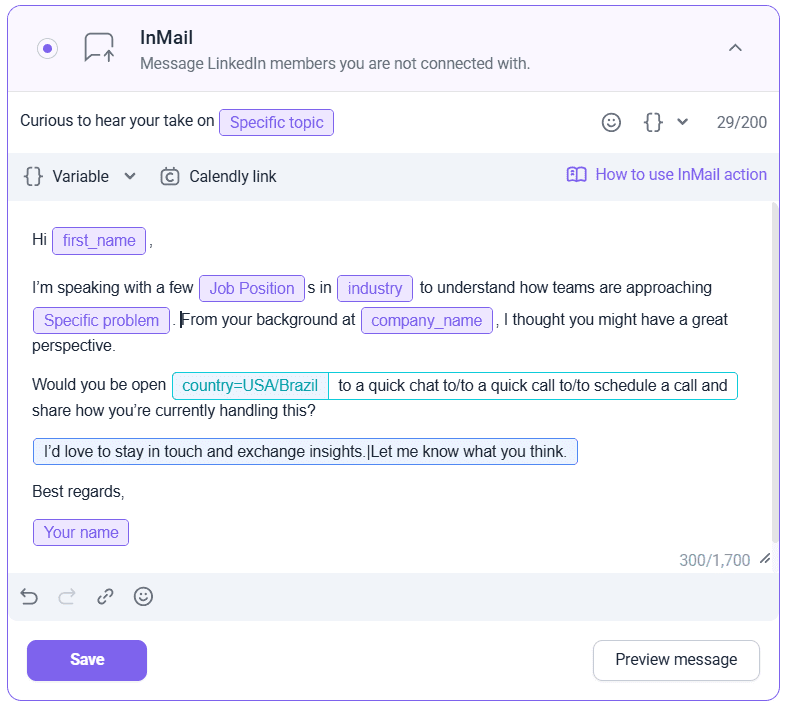
You can also use Spintax variables to automatically generate multiple unique versions for one message. Or you can create Custom variables, using your leads’ data to make your outreach feel even more personal.
7. Leverage employee advocacy
Your team, with their unique networks and voices, can effectively complement your LinkedIn prospecting techniques. Think of it as transforming every employee into a mini-influencer for your company.
Turn content sharing into a team sport
When shared by employees, your company’s content travels into new territories, reaching potential leads you didn’t even know existed. Their networks bring your brand into new conversations, opening new opportunities for lead generation.
Besides, when your employees share your latest blog post or celebrate a company milestone on LinkedIn, it’s not just about reach; it’s about adding a personal, authentic touch. It’s like saying, “Hey, check out this cool thing we did at work!” but in a professional, LinkedIn-y way.
So, encourage your team to post about their work wins or industry thoughts. This will help you showcase expertise, establish credibility, and add a human touch that no corporate page can replicate.
|
📌 Expert tip: Balance guidelines and creativity Set some ground rules for content sharing, but don’t stifle creativity. Imagine giving your team a box of crayons and a coloring book, but letting them choose the colors. This balance ensures they also bring their personal flair to the table. And don’t forget to celebrate your standout employee advocates. This can be a shoutout in a team meeting or a feature in your company newsletter acknowledging their efforts and keeping the advocacy vibe alive and kicking. |
8. Use webinars and Live events for lead generation
One of the most underutilized yet powerful lead magnets is LinkedIn events. These events are not just for learning or networking; they are a true prospecting powerhouse.
Think of it as having a list of all the attendees at an event related to your niche—each one a potential lead. LinkedIn Events offers just that.
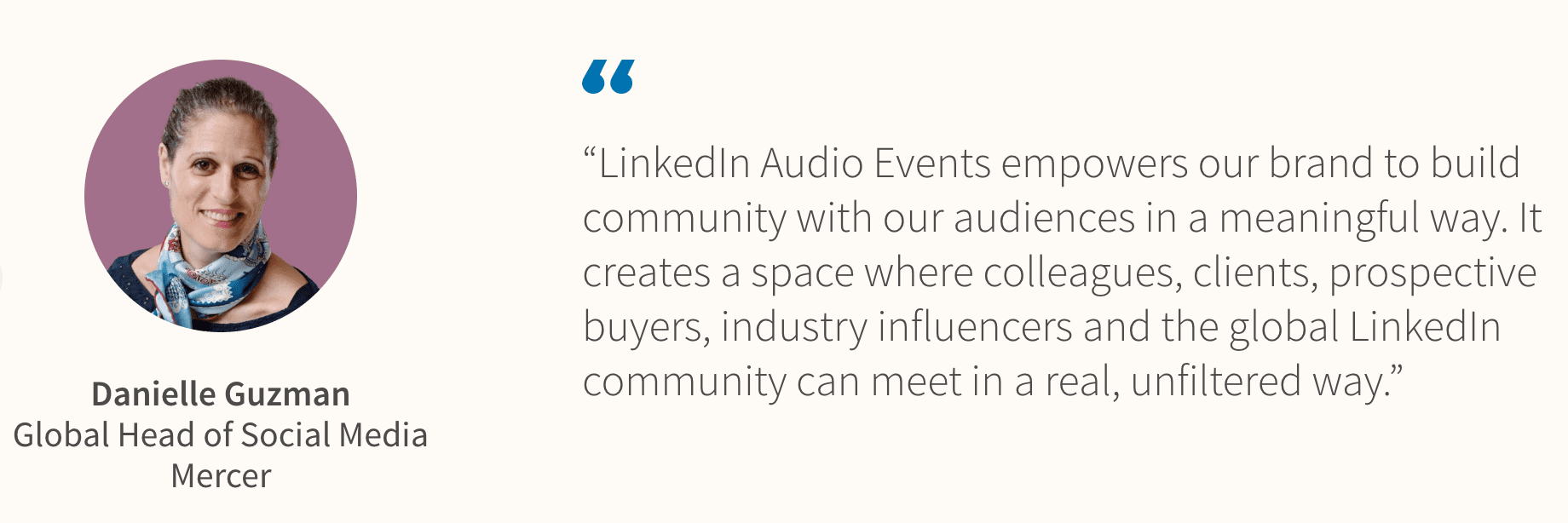
By browsing the list, you can identify prospects who engage with the topics you specialize in, indicating a higher likelihood of interest in the solutions you offer. Instead of cold outreach, you have a warm inroad that creates more opportunities to generate B2B leads.
Using these hidden features, you can enhance your LinkedIn lead generation strategy and connect with leads who are more likely to convert because they’re already part of the conversation.
9. Leverage LinkedIn ads
LinkedIn Ads come in various flavors, each with its unique strengths. There’s the classic Sponsored Content for boosting posts right into your target audience’s feed, Display Ads for that visual punch, and Sponsored InMails for direct, personalized messaging. All features are available in Campaign Manager.
To successfully generate leads on LinkedIn, we recommend trying the following advertising features as well:
Lead Gen Forms
Lead Gen Forms Ads are a relatively new feature for you to try. They can simplify the lead collection by pre-filling forms with LinkedIn profile data. Users are more likely to complete the form because it’s just a click away—no more typing out contact details on tiny mobile keyboards!
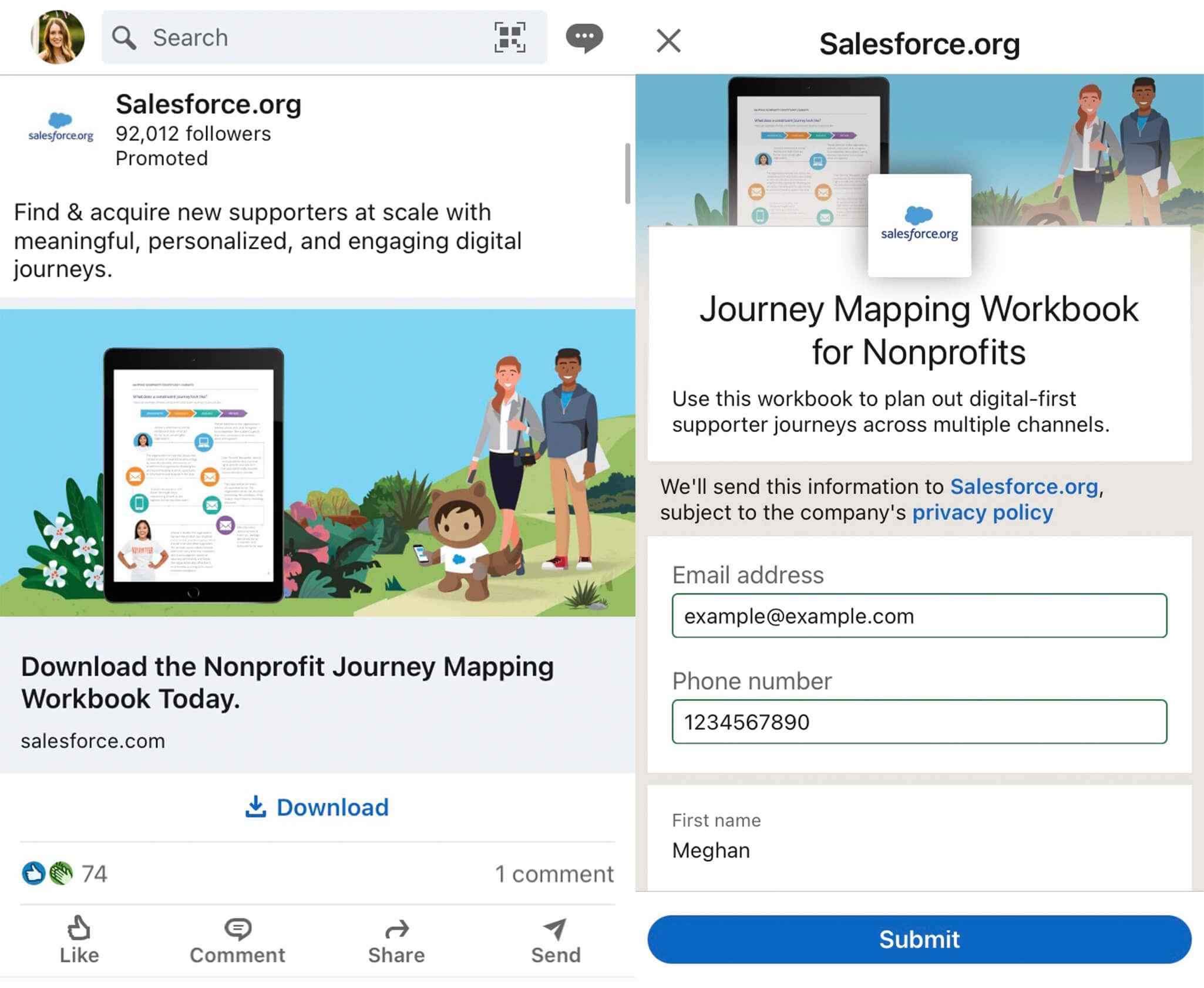
Ad Targeting
That’s another handy feature for generating leads. You can zero in on prospects based on job titles, industries, company sizes, and even interests. Here’s how to make the most of it:
- Target by job titles to reach decision-makers or specific professionals. This way, CEOs, Marketing specialists, Engineers, or people holding any specific role relevant to your product or service will see your ads.
- Tailor your ads based on the industry (like tech, finance, healthcare, etc.) and the company size (from startups to large enterprises). Design your product or service for particular business types or stages.
- You can target LinkedIn users based on their interests and group memberships. This is great for tapping into niche markets or aligning with specific professional interests.
Retargeting
You can also keep your brand at the forefront of people’s minds through various forms of retargeting, such as:
- Website retargeting. Using the LinkedIn Insight Tag, you can retarget visitors who’ve been to your website and re-engage those who have shown interest but haven’t taken further action.
- Video and lead form retargeting. If someone watched your video ads or interacted with your Lead Gen Forms but didn’t convert, retarget them. Offer something additional to tip the scale in your favor.
- Retargeting by engagement. You can also retarget users who have engaged with your LinkedIn content. This includes reactions, comments, or shares indicating an initial interest in your brand or message.
Detailed targeting and retargeting tools help your ads be seen by the right people and consistently stay in front of those who have shown some level of interest, increasing the likelihood of conversion.
10. Craft PDF lead magnets to empower LinkedIn outreach
Imagine you have a neat, useful PDF—maybe a cheat sheet for SEO, a beginner’s guide to digital marketing, or a list of top industry tips. You offer it for free on LinkedIn, and in return, people give you their email. It’s a trade: they get valuable info from you, and you get more leads.
How to craft PDFs that pop
- Pick a hot topic. Think about what your audience really wants to learn. Say, if you’re in graphic design, how about a PDF on “Top 10 Design Hacks for 2026”?
- Make it worth their time. Your PDF should be like a secret recipe for users – full of helpful stuff they can apply.
Look good, feel good. An easy-to-read and beautiful design can turn a good PDF into a great one. Throw in some appealing visuals or infographics to keep things interesting.
How to get your PDF out there
The simplest way is to share a snippet or an interesting fact from your PDF in a LinkedIn post. Make them think, “I need this doc!”.
You can also use ads for extra oomph. Just put your PDF in LinkedIn lead generation ads and target them at the folks who’ll love it most.
11. Enhance lead generation with omnichannel marketing
Ever wondered how to get leads from LinkedIn beyond the platform? In 2026, it’s possible with omnichannel marketing.
Omnichannel just means connecting with people through many different ways – LinkedIn, emails, your website, and other social media sites – and ensuring the vibe is the same everywhere. Use what you know about your audience to make your messages relevant and engaging.
How to make it happen
- Maintain consistency. Whether it’s a LinkedIn post, an email, or a tweet, keep your content in line with your personal style.
- Use personalized data. Pay attention to what posts your audience likes or what emails they open to make your messages resonate with them.
- Mix it up across channels. For example, if someone checks out a post on LinkedIn, why not send them an email with more details on the topic?
Keep an eye on what’s working. Certain posts perform better than others? Specific emails bring you more clicks? Focus on these winning strategies. If something’s not hitting the mark, change it up. Always be ready to tweak your strategy to keep your audience engaged.
|
📌 Expert tip: Save time and effort by automating your multichannel outreach. With tools like Snov.io, you can reach leads both on LinkedIn and via email by combining cold email sequences with LinkedIn touches, such as profile views, connection requests, post likes, messages, and InMails. All touchpoints are automated, so you can focus on more strategic tasks.
|
Top LinkedIn lead generation tools
Before you start building a LinkedIn lead generation strategy, let’s quickly run through a few tools to support your efforts. These apps and platforms will help you acquire and nurture prospective customers, but also nurture them up to the deal closing stage.
Here are LinkedIn lead generation tools you may need to boost results:
- Sales Navigator. Leverage advanced filters to find high-value LinkedIn leads and use real-time alerts on their activity to tailor your lead generation strategy.
- Campaign Manager. Launch ad campaigns based on professional data such as job title, industry, and seniority, to generate B2B leads at scale.
- Snov.io LinkedIn automation tool. Put your lead generation efforts on autopilot while ensuring seamless engagement and personalization at scale.
- LI Prospect Finder. Collect leads’ profiles enriched with data and use verified contact details for multichannel campaigns. You can try this LinkedIn lead generation tool for free.
- Snov.io Multichannel campaigns. Build personalized LinkedIn+email campaigns to connect with prospects through the channel they prefer.
Snov.io helped us collect more than 80,000 leads in a month, accelerating our search for emails while reducing the cost per lead.
CMO at Belkins
Key takeaways
The success of all LinkedIn lead generation strategies depends on how well you show up and engage on the platform. Whether your tactic involves profile optimization, valuable content, meaningful interactions, or targeted ads, ensure it reflects your goals and speaks to the people you actually want to reach.
I hope our LinkedIn lead generation guide will help you significantly expand your lead lists, strengthen your online presence, and attract high-quality prospects systematically. And if you want to empower your lead generation efforts, it’s time to try automation solutions like Snov.io.
With this platform at hand, you’ll be able to transform the vast landscape of the professional network into a navigable map of potential opportunities!


